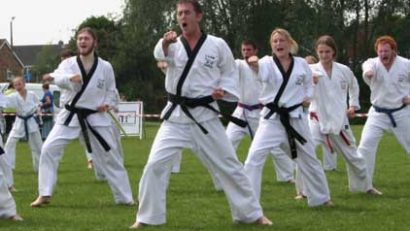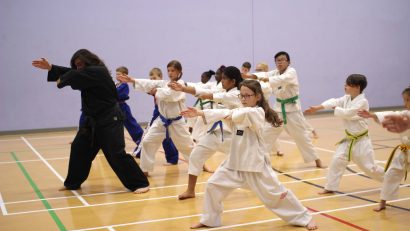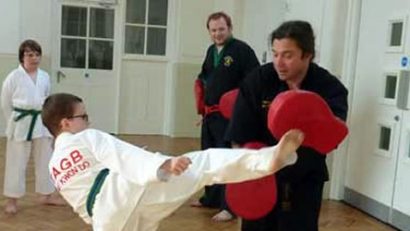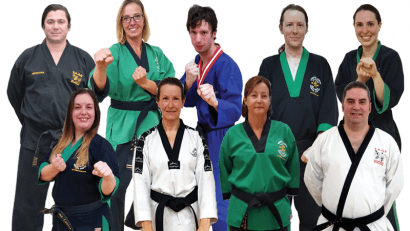All the syllabus for current white belt yellow tag students to learn in order to gain their yellow belt.

Linework
Identify yourself
Static linework
Sitting stance, double punch X 10 counting out loud in Korean, change hands, repeat.
Walking ready stance, front snap kick X 10, change legs and repeat.
Moving linework
L Stance – Middle Inner Forearm Block
L Stance Middle Block, slip front foot to Walking Stance Middle Reverse Punch.
Front Snap Kick land L Stance Forearm Guarding Block
L Stance Forearm Guarding Block
L Stance – Knifehand Strike
Walking Stance Rising Block
Walking Stance Low Block/Rising Block


Pattern
At this grade the student learns the very first TaeKwon-Do pattern – Chon-Ji.
What is a Pattern?
A pattern is a set of fundamental movements, mainly defence and attack, set in a logical sequence to deal with one or more imaginary opponents. Patterns are an indication of a student’s progress – a barometer in evaluating an individual’s technique.
Why Do We Perform Patterns?
We practice patterns to improve our TaeKwon-Do techniques, to develop sparring techniques, to improve flexibility of movement, master body-shifting, develop muscles, balance and breath control. They also enable us to acquire techniques which cannot be obtained from other forms of training.
Why Are There Twenty Four Patterns?
The reason for twenty four patterns in TaeKwon-Do is because the founder, Major General Choi Hong Hi, compared the life of man with a day in the life of the earth and believed that some people should strive to bequeth a good spiritual legacy to coming generations and in doing so gain immortality.
Therefore, if we can leave something behind for the welfare of mankind, maybe it will be the most important thing to happen in our lives, as the founder says:
“Here I leave TaeKwon-Do for makind. As a trace of man of the late 20th Century. The twenty four patterns represent twenty four hours, one day, or all of my life.”
The Following Points Should be Considered When Performing Patterns
- Patterns should begin and end on the same spot. This will indicate the performers accuracy.
- Correct posture and facing must be maintained at all times.
- Muscles of the body should be tensed or relaxed at the proper critical moments in the exercise.
- The exercise should be performed in a rhythmic movement with the absence of stiffness.
- Each pattern should be accelerated or decelerated according to instructions.
- Each pattern should be perfected before moving to the next.
- Students should know the purpose of each movement.
- Students should perform each movement with realism.
Chon-Ji
Chon-Ji means literally “the Heaven and the Earth”. It is in the Orient interpreted as the creation of the world or the beginning of human history, therefore it is the initial pattern played by the beginner. This pattern consists of two similar parts, one to represent the Heaven and the other the Earth.
For Children under 10: ‘Heaven and Earth’ is a good enough answer!
Note: (you don’t need to learn this bit, it’s just interesting!): the pattern takes its name from lake Chon-Ji which is formed in the crater of an extinct volcano called Paektu on the border between China and Northern Korea – the lake perfectly reflects the sky (heavens). Chon-Ji is said to be the spiritual home of the Koreans.
Number of Movements: 19
Starting Position – Parallel ready stance

The diagram for this exercise assumes that the student is stood on line AB and is facing D.
- Move the left foot to B forming a left walking stance, executing a left low block.
- Move the right foot to B forming a right walking stance, executing a right middle punch.
- Move the right foot to A, turning clockwise to form a right walking stance toward A, executing a right low block.
- Move the left foot to A forming a left walking stance, executing a left middle punch.
- Move the left foot to D forming a left walking stance, executing a left low block.
- Move the right foot to D forming a right walking stance, executing a right middle punch.
- Move the right foot to C turning clockwise to form a right walking stance toward C, executing a right low block.
- Move the left foot to C forming a left walking stance, executing a left middle punch.
- Move the left foot to A forming a right L-stance toward, executing a left middle block.
- Move the right foot to A forming a right walking stance, executing a right middle punch.
- Move the right foot to B turning clockwise to form a left L-stance toward B, executing a right middle block.
- Move the left foot to B forming a left walking stance, executing a left middle punch.
- Move the left foot to C forming a right L-stance toward C, executing a left middle block.
- Move the right foot to C forming a right walking stance, executing a right middle punch.
- Move the right foot to D turning clockwise to form a left L-stance toward D, executing a right middle block.
- Move the left foot to D forming a left walking stance, executing a left middle punch.
- Move the right foot to D forming a right walking stance toward D, executing a right middle punch.
- Move the right foot to C forming a left walking stance toward D, executing a left middle punch.
- Move the left foot to C forming a right walking stance toward D, executing a right middle punch (with kihap).
When called to return to ready stance (barro), bring the left foot back to the ready position.
Theory
At your ninth kup grading you will be asked questions from any of the following:
Meaning of Yellow Belt
Yellow belt signifies earth, from which a plant sprouts and takes root as the TaeKwon-Do foundation is being laid.
- What is the meaning of Pattern Chon-Ji and how many moves does it have? See above for the answers.
- Identify or demonstrate L-stance. What is the weight distribution for L-stance? 70% on the back leg, 30% on the front.
- Identify or demonstrate Forearm Guarding Block. Identify and name the blocking tool? It is the outer forearm.
- Identify or demonstrate Knifehand Strike. Identify and name the striking/attacking tool? It is the knifehand.
- Identify or demonstrate Rising Block. Identify and name the blocking tool? It is the outer forearm.
- Indentify or demonstrate Front Snap Kick. Name and identify the attacking tool? The ball of the foot.
- What are the Tenets of TaeKwon-Do? Courtesy, Integrity, Perseverance, Self-Control, Indomitable Spirit (see The Basic Theory and History of TaeKwon-Do).









